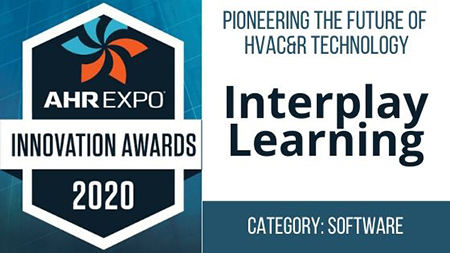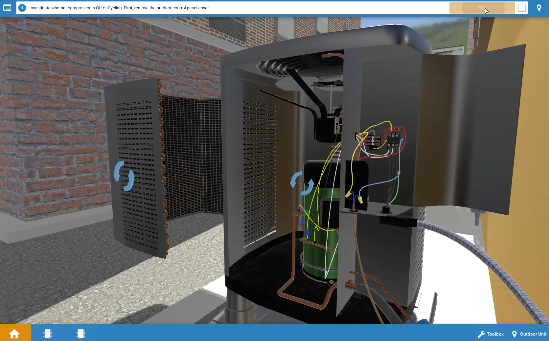

Virtually Solving the Industry’s Labor Shortage
Point-of-view, video game-like training could help solve the HVAC&R industry’s skilled labor shortage.
Interplay Learning’s (Booth 8562) SkillMill Skilled Trades Course Catalog is based in simulation learning that provides on-the-job training simulation to technicians.
“But instead of killing the bad guy, you’re troubleshooting a heat pump for fixing a split residential AC system,” said Doug Donovan, CEO of Interplay Learning.
Other fields such as aviation, medicine and military have been using simulation as an education tool to mimic experience in a short amount of time, he said.
“It’s really that technology and that educational approach that we use to learn technical skill sets for HVAC technicians,” he said. “We’re now delivering the fastest way to a skilled worker.”
The winner of the 2020 AHR Expo Innovation Awards software category, Interplay’s SkillMill courses provide 3D training and virtual reality training for residential air-conditioning systems, gas furnace systems, gas boiler systems, commercial air-conditioning systems, heat pump systems and 12.5 ton rooftop units. The online catalog has hundreds of hours of learning of on-demand training courses designed for HVAC professionals to gain worksite skills. The courses are accessible on mobile phones, computers, tablets and in virtual reality.
 Interplay Learning’s SkillMill course catalog addresses residential air-conditioning
Interplay Learning’s SkillMill course catalog addresses residential air-conditioning
systems, gas furnace systems, gas boiler systems, commercial air-conditioning systems,
heat pump systems and 12.5 ton rooftop units.
Traditionally, the on-the-job training for HVAC technicians takes months and years for someone to learn what they need to know, said Donovan. Two-year school programs that teach skilled labor trades can be a challenge to balance costs and schedules. Interplay’s tool has applied educational technology to the HVAC industry to quickly develop skilled technicians. The software can lessen the skilled labor gap because it makes learning more accessible and efficient, said Donovan.
“Simulation is a way to condense learning time because you can get a lot of repetitions in a short amount of time,” said Donovan. The virtual, real-feel courses do not replace needed hands-on training, but they are a tool to make that time more valuable and efficient, he said.
How Does It Work?
SkillMill includes skilled trades training courses from foundational to advanced, said Kristina Bentle, Interplay’s marketing director. Subject matter experts create courses that address foundational applied sciences to advanced concepts such as diagnosing refrigerant overcharge. The expert-led video courses are designed to increase the learners’ understanding, and the interactive 3D-based troubleshooting simulations deliver field-like training. The course catalog includes training on solar energy, HVAC, multi-family housing, electrical and plumbing.
“SkillMill is the world’s first online learning experience platform offering a catalog of on-demand, video-based and first-hand, VR-enabled training solutions for HVAC and other skilled trades,” said Bentle. “With our proprietary software, VOLT™, we can create a wider variety of real-world scenarios and situations quicker and more economically (in only a few weeks rather than months or years), making training easily available to more people. This makes training more scalable, effective and affordable.”
 An HVAC student uses Interplay Learning’s SkillMill courses’
An HVAC student uses Interplay Learning’s SkillMill courses’
virtual reality feature to learn about troubleshooting systems.
Interplay’s state-of-the-art 3D simulations create immersive learning environments for users, said Bentle, adding that technology was once costly and reserved for heavily capitalized industries such as aviation and military. Now, she said the technology is affordable and accessible to the skilled trades industry.
“Traditional training methods alone can’t help close the skills gap quickly enough. Interplay knew that technology could help the trades solve some of these problems,” said Bentle.
Beyond the Software
Donovan said Interplay Learning has been building point-of-view simulation learning since 2010. Since then, technologies such as virtual reality have grown. The company has built simulation technology products to help laborers learn technical skills for applications from HVAC to electrical to working a six-axis robot on a factory floor to installing solar panels, he said.
Over the years, Donovan said Interplay Learning’s team of instructional designers, programmers and engineers has created solutions to help users learn more efficiently using simulation. In 2016, Rogan Griffin, who has experience working with scaling animation capabilities for Pixar Animation Studios, became Interplay’s chief technology officer. Griffin helped the team build an engine that allows Interplay Learning to build the courses quickly and maintain them, said Donovan.
Throughout the years, the team has faced challenges. Teaching technical skill sets based on industry best practices is a challenge, said Donovan. Finding best practices the industry is comfortable and reaching agreement among experienced technicians and subject matter experts is complicated because everyone does their jobs slightly differently. He said typically Interplay Learning uses at least three subject matter experts who contribute to the content development.
Another challenge is cost-effectively mimicking systems in a virtual setting, he said.
“We really make the system work the way it really does in the real world,” Donovan said, adding Interplay’s courses mimic the electrical and mechanical behavior of the systems. This allows technicians to learn how a system actually reacts when something goes wrong.
Since October of 2019, Interplay Learning has added more than 500 HVAC companies as customers including several big industry manufacturers for whom Interplay Learning is delivering training for their specific products, according to Donovan.
For additional coverage of AHR Expo, visit ASHRAE Journal's AHR Today web page.